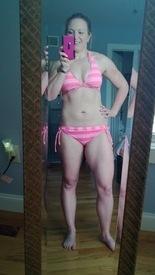Accuracy of Body Fat Testing Devices [Research]

geekyjock76
Posts: 2,720 Member
Lots of people use BIA (Bioelectric Impedance Analysis) devices, including handheld and foot scale models, to estimate body fat percentage. As many already know, they can be off on estimations and many factors affect the device's validity and accuracy: body temperature, hydration levels, hormonal changes, etc. However, your body fatness - or degree of adiposity - may also lead to overestimations and underestimations. In one study, handheld devices over a 5 day period were off by 2-10% and foot scales between 3-5%.
Here is a study that demonstrated the validity and accuracy of BIA devices in estimating whole body fatness compared to DEXA (Dual Energy X-ray Absorptiometry), which many consider the 'gold standard" in testing:
Here is a study that demonstrated the validity and accuracy of BIA devices in estimating whole body fatness compared to DEXA (Dual Energy X-ray Absorptiometry), which many consider the 'gold standard" in testing:
http://ajcn.nutrition.org/content/81/1/74.fullThe major contribution of the present study is the demonstration that the size and direction of the BIA-DXA difference in adults is dependent on the %BF of the subject (low, medium, or high). BIA tends to overestimate body fat when subjects are relatively lean and underestimate body fat when subjects are overweight or obese. Furthermore, the cutoffs between these groups differ in men and women. BIA tends to overestimate body fat when %BF is <15% in men and <25% in women (lean). BIA tends to underestimate body fat when %BF is >25% in men and >33% in women (obese). These cutoffs define obesity according to %BF (38). Little difference was seen when BIA was used in men with %BF between 15% and 25% and in women with %BF between 25% and 33% (normal). These findings have important implications for the use of BIA measurements and the interpretation of results.
BIA overestimated %BF by 3.03% and 4.40% when %BF was <15% in men and <25% in women, respectively, and underestimated %BF by 4.32% and 2.71% when %BF was >25% in men and >33% in women, respectively.
0
Replies
-
True but I thought the point was to use a device and stick with it, hopefully seeing the number going down. I know I always take these estimates with a grain of salt. Thanks for posting though.0
-
I prefer to test people 3-5 days in a row [if possible] using the handheld device because it will provide a clearer picture as to what their percentage may actually be rather than doing so once every few weeks. It's a quick way to estimate body fatness but many may not be aware of the magnitude of deviation depending on their degree of adiposity. I rather use calipers myself but some people are not comfortable with that method.0
-
I test myself several days in a row as well under the exact same conditions. I thought calipers weren't as accurate the leaner you got because you're dealing with a fraction of an inch. I find the scale to be easier than the calipers ever were. But whatever method works for you. I maintain that it should be the same method so you can get a somewhat accurate picture of where you are at. Bouncing from device to device is not an optimal/ideal way to track body fat IMO.0
-
I don't mean to hijack, but since it relates directly to the topic, and I find James Krieger to rank up their among the best people to listen to:
The Pitfalls of Body Fat “Measurement”: Part 1
http://weightology.net/weightologyweekly/?page_id=1460 -
I have the bio electrical impedance hand held at home. and I try to use it on myself an a regular basis at the same time of day and such so the results are not too thrown off. But for clients, I use the skin fold test. I feel that is a lot better to test with on people youare actually working with.. You just have to be sure that you are pinching correctly.0
-
Bump- Great info as always GeekyJock!0
-
I'm happy to see this thread today. I just had a friend call telling me she weighed and measured on her sisters ADE scale and it showed her at 32% BF and she was floored. She's 5' 6", 124 and that sounded oddly high to me for someone with those measurements.
For me, I use the US Military (NAVY) BF% measuring method and just check it every 30 days to make sure I'm heading in the right direction. Thanks for the thread and the links. 0
0 -
Thanks, SideSteel. I've referenced his article - which is one of the best - on this topic to a few clients before to explain the degrees of prediction on several available testing methods. I think, whether its scale weight or body fat testing, people sometimes get too caught up in the numbers given. With BIA testing, a person could realistically have lost nearly 4% of body fat yet the device may show no change or even an increase up to 4%. I witness this nearly everyday, although not that degree of variation, when I test it on myself.I don't mean to hijack, but since it relates directly to the topic, and I find James Krieger to rank up their among the best people to listen to:
The Pitfalls of Body Fat “Measurement”: Part 1
http://weightology.net/weightologyweekly/?page_id=1460 -
I use the "Are my thighs fat?" method. If the answer is yes, I keep going.0
-
My handheld device is currently my BFF. I'm 5-8, 263 pounds and my Omron fat-loss monitor puts me at 35 percent body fat. That means, according to this little gadget's calculations, I'm hauling around a whopping 171 pounds of lean mass.
According to my BFF, I only have 92 pounds of body fat! Take that, BMI! (I'd have to lose 99 pounds and weigh 164 to reach a "healthy" range per BMI standards.)
Here's the problem: I know my body fat percentage is higher than 35%. It has to be. If it REALLY was 35%, that means I'll be in the fit/athletic range per BF% standards when I get to 193 pounds. Ha! That would barely get me out of the BMI's "obese" range — and, trust me, I ain't no muscular athlete. Not yet, at least.
Honestly, I wouldn't be shocked at all if my actual body fat percentage was closer to 45% rather than the alleged 35%. I'd love to get a test done in a Bod Pod to get an accurate test.
In the meantime, I'll keep thanking my BFF for telling me I'm not as fat as I really am. Then again, that's probably not a good thing.0 -
I use the "Are my thighs fat?" method. If the answer is yes, I keep going.
Boom! I use the "am I storing nuts for the winter in these cheeks" test.0 -
My method is, "If I do jumping jacks, how long after I stop jumping does it take my body to stop bouncing?"0
-
I like to do calipers every morning, I generally get consistent results with an occasional outlier, which is very obvious, since I do it every day. More of an obsession with data points than really caring about all those numbers.0
-
I don't mean to hijack, but since it relates directly to the topic, and I find James Krieger to rank up their among the best people to listen to:
The Pitfalls of Body Fat “Measurement”: Part 1
http://weightology.net/weightologyweekly/?page_id=146
Good stuff. 0
0 -
Interesting findings! Thank you for posting this study. I actually thought they were even less accurate than that because of misinformation around the board.0
-
My method is, "If I do jumping jacks, how long after I stop jumping does it take my body to stop bouncing?"
LOL. So true!!!0 -
I find those devices to be very inaccurate. Personally I like the DXA or hydrostatic test. I found a DXA for $85 and it was covered under health care. It had the added benefit of giving me my bone density which is important for us females over 50. For me it proved that my lifting for so many years has warded off osteoporosis, the technician told me I have the bone density of a super athletic 30 year old and I am almost 52!0
-
Yes, for women above 40 - or younger women with a history of chronic eating disorders such as anorexia - I recommend the DEXA for that exact reason.0
-
The non-elasticized pants test is pretty reliable for me as far as losing or gaining any fat, since I tend to wear my jeans snug. It's the mid-section that tells the story IME. If one is gaining inches there, it's pretty sure one is gaining fat. If one is losing inches there, losing fat. One doesn't have to always know exact percentages.
IME, the body fat testing I've had in the past has usually been really wonky, like being measured with calipers at the gym and it coming out 32% body fat and being given a doleful lecture about how dangerous this high percentage is and all. And this is with working out and NOT being fat(OK still a little extra in the tummy) at 118 pounds! My husband had similar experience at the gym - here he is in excellent shape and the calipers on him read out 26% which would be quite fat on a man, but less so on a woman. Half the time I think the trainers read out really high body fat percentages so they can sell one on their services etc! Maybe not everyone does this but it bears thinking about. Another time, earlier in life, with being in very good shape from gym work in my 30s, I had the bio-impedance method done and was 27% body fat at 109 pounds(I'm just under 5'5" and small-boned). Even the person who did the bio-impedance was surprised at such a high reading as he thought I looked like I was in very good condition.0
This discussion has been closed.
Categories
- All Categories
- 1.4M Health, Wellness and Goals
- 398.2K Introduce Yourself
- 44.7K Getting Started
- 261K Health and Weight Loss
- 176.4K Food and Nutrition
- 47.7K Recipes
- 233K Fitness and Exercise
- 462 Sleep, Mindfulness and Overall Wellness
- 6.5K Goal: Maintaining Weight
- 8.7K Goal: Gaining Weight and Body Building
- 153.5K Motivation and Support
- 8.4K Challenges
- 1.4K Debate Club
- 96.5K Chit-Chat
- 2.6K Fun and Games
- 4.7K MyFitnessPal Information
- 17 News and Announcements
- 21 MyFitnessPal Academy
- 1.5K Feature Suggestions and Ideas
- 3.2K MyFitnessPal Tech Support Questions








